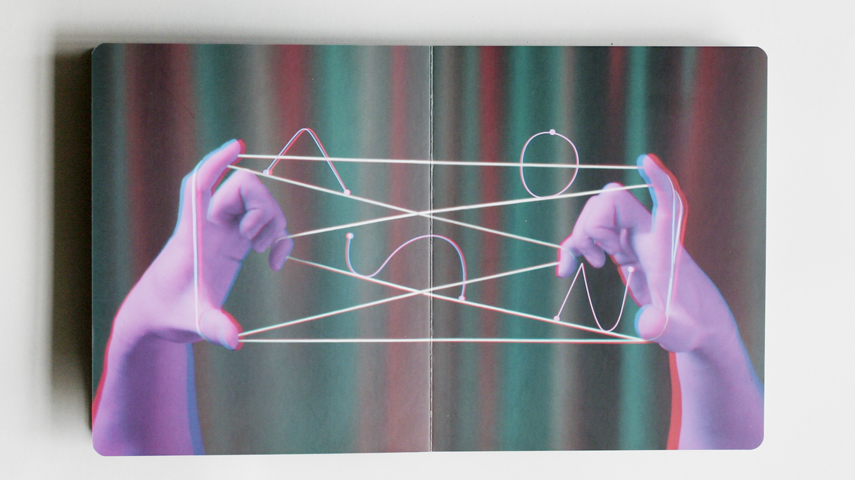Por trás da brincadeira da cama de gato está a vontade de inventar desenhos com o corpo, de mostrar a delicadeza de sustentar um jogo, sem competição, onde o objetivo é apenas desenhar com as mãos. O participante, a qualquer momento, pode levar sua trama à um nó e ter de recomeçar.
Em 2008, usando uma câmera fotográfica 3D, estudando o jogo da cama de gato, produzindo fotos e zines, chegou-se na imagem que serviria de base ao livro: Uma mão em cada página e as linhas da cama de gato sobrevoando a superfície do papel. A leveza das mãos, não revela as posições nada naturais durante o clic. Muitas sessões de foto até conseguir a textura, a luz e o tamanho certo das imagens.
O livro apresenta 23 anáglifos num clima de circo, onde os pontos cardeais tentam formar uma rosa dos ventos. Impresso em 4 x 4 cores, livro cartão, 46 páginas, 15,8 x 19 (H) cm, óculos 3D incluídos. Produção de fotos, André Brandão. Assistência no tratamento e composição das imagens 3D, produção de cenário, bonecos e zines, parceiro no jogo da cama de gato, Erick Fugii. Publicado pela Cosac Naify.
—
Interview to Picturebook Makers:
The first of the two books I will talk about in this post is called ‘Os Pontos Cardeais Acrobatas’ (The Acrobatic Cardinal Points). This project began on a trip to Japan in 2008 when I found a magazine that came with a cutout 3D pinhole – one of those unbelievable Japanese objects. When I got back to Brazil I produced a series of publications made with this machine and also some 3D drawings. I often start with small fanzines and sketches that I can consult in order to design a book.
The challenge was to use 3D language as a poetic device and not just a magical effect. It was also essential to consider the book as an object, with simple things like sheets superimposed, bound and folded to one side, with the intention of being able to leaf through from one side to another – a device I am always returning to in my work.
Behind the cat’s cradle game is my admiration for creating drawings with the hands in which the vertices are our own fingers. There is a delicateness in keeping the game going, without competition, where the goal is only to create figures. The players can afford to risk, at any moment, seeing their figures dismantled or becoming a knot. In this book, each hand is located on one page. By leafing through the pages, the hands touch each other like in the real game, and the lines fly over the book. That was the image which I pursued and wanted to see in print.
With the help of a photographer friend and assistant designer, we carried out around five photo sessions in a studio to get the texture, the light and the size of the images. We also captured the texture and the colour of the curtain and the lines, as well as the gesture of the hands (curiously this led us into unnatural positions at the time of shooting). In my childhood, the cat’s cradle had never been my speciality, so it was necessary to study the game – learning from specialised books to get a sequence of steps to be shown throughout the book.
On the photographed lines I decided on a graphic intervention. Perhaps by virtue of my motivation as an illustrator, I created characters balancing on the tightrope. It reminded me of a play that takes place on the moon by Vicente Huidobro (a Chilean poet who inhabits my depths), where four trained cardinal points are presented.
After personally seeing Calder’s circus in MoMA’s collection, as well as the books of Sol LeWitt, it became easier to realise these single characters. While hands play to make stars with the string, the cardinal points dance with each other and become a rainbow, a compass rose, a tower, and various other things.

















